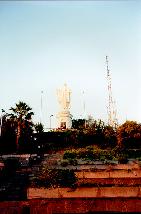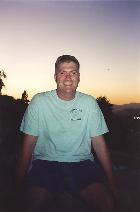|
 |
|
|
The next day I awoke and ate a nice breakfast
with Carol and Jay before leaving the house to wander around and be a tourist.
I rode the metro down to the Santa Lucia park, which is a big bunch of
rocks with decorative battlements and gardens and paths on it. It was the
place that the first Spaniards to reach the area spent the night, probably
because it was easily defensible. As I walked up towards the top, I was
accosted by a couple of english-speaking Chilean college students asking
for money for school in exchange for some poetry photocopied onto red sheets
of paper. I must admit I wasn't very receptive to giving them money, especially
after I found out one was a computer major. It certainly seemed to me that
he could make more programming or doing anything geeky then panhandling
for poetry. I gave his girlfriend about a dollar though; it was her poetry.
At the top I met an American couple. He had finished his time in the Peace
Corps, and they had just rode across the continent on a bus. I talked with
them for a bit and relayed the latest news of California flooding from
home. Later that day I ran into them again, wandering through a shopping
mall. |
 Me
on top of the Santa Lucia. There should be a snow covered mountian in the
background, but it was hazy. Me
on top of the Santa Lucia. There should be a snow covered mountian in the
background, but it was hazy. |
|
I walked down the mountain and past the art museum, which
was showing a Dali exhibit. I stopped outside for a while, trying to decide
if I should go in, but the city seemed more interesting. I hit the river
that ran through town, which had quite a bit of water running through it.
There were a few surfing waves and such, but the water was a uniform brown
even where it normally would have been white, so it looked a little yucky.
I followed the river down to the old train station, which had been converted
into some restaurants and a market selling fish and vegetables and meat.
It was early for lunch and I was accosted by the waiters from each of the
empty fancy restaurants as I walked by. I eventually found a place that
looked like where the workers went for lunch. It was a little hole in the
wall with three seats and an old lany making empanadas. For 75 cents I bought
an empanada, which is a triangular meat filled pastry, and a orange Crush
and sat at the counter trying to read an old newspaper article that was
hung on the wall and apparently was about the place I was eating. I couldn't
see what it said, but it didn't mention anything about anyone dying, so
I felt better - until I left the lunch place and was immediately confronted
with the butcher's display case that contained all
the parts of a cow you normally wouldn't think about eating. That made
me wonder what had actually been in the thing that I ate, but it was too
late to do anything about so I moved on. |
 The
river that runs through town - I don't know what made it so brown, but
there was a nice surfing wave in the foreground. The
river that runs through town - I don't know what made it so brown, but
there was a nice surfing wave in the foreground.
 Inside
the market in the old train station. Inside
the market in the old train station.
|
|
Now I went into serious tourist mode. I
went first to the Casa Colorada, an old house that has survived mostly
intact since the old days of the city. It has a series of little models
and pictures and diaramas of the development of Santiago from when the
Arucanian indians lived there until reletively modern times. It was a pretty
cool museaum - my spanish had rotted enough that I couldn't follow all
the narrative, but it was very interesting none the less. I then went
over to the pre-colombian museum, which had many artifacts from different
civilizations. The one that was featured when I was there was the Nasca
indian civilization, that had lived during its time in the far north of
Chile and in Peru. They are perhaps best remembered for drawing the large
figures out in the desert. They seemed to be fascinated with death, and,
as I read, worshipped death in three forms - that of the "horrible
bird", the orca and something that I didn't see because I was too
excited about the orca reference. You see, my friends here in school are
mostly marine biology people, who know alot about and study marine mammals.
One time they showed me something that amazed me - pictures of a killer
whale surfing a wave onto shore to catch a seal. Ever since then I
have been somewhat expecting to be walking along a beach and have a killer
whale come surf in afetr me. Women think it's romantic to let them walk
on the sea side at night; for me, its a survival measure. Anyway, so I
immediately assumed that what must have happened is a orca surfed onto
shore and ate someone important to the Nasca indians, thus creating a new
part of their religion. They had stylized pottery showing the orcas with
human heads floating inside them, and I looked all around for a way to
take a picture to show to everyone when I got back, but each room had a
guard and I couldn't find a way. The bookstore didn't even have a book
with a picture of the piece I wanted. It was very dissapointing.
I left the museaum and strolled around downtown looking into shops and
in some malls for little gifts I could bring back. I didn't find any there,
though. I did buy a spanish dictionary - the little phrase book I had had
proved inadeqaute so far. I also bought a calendar with pictures of Chilean
wilderness. I only did it because of the picture and description of the
Futaleufu it contained: "In the summer, fearless rafters and expert
kayakers test their skills on the mighty Futaleufu." It made me wonder
why the kayakers could be scared, even if the rafters didn't seem to need
skill. I then passed by the Palacio de la Moneda, the official governemnt
building that I had seen pictures of being bombed during the coup that
brought Pinochet to power. It looked pretty good; they had had a long time
to fix it.
|
 The
Virgin Mary on top of the Cerro San Cristobal at sunset. The
Virgin Mary on top of the Cerro San Cristobal at sunset. |
|
I made it back to Carol's house and Jay offered
to take me out to a place that sold handicrafts. We drove up there and
wandered around a market that had stalls, each of which made and sold some
handicraft. To be honest, I really wasn't taken by much but bought what
I liked. I got a painted piece of glass for my mom to put up, some little
carved nuts that when opened had a cute bug that wiggled around and a leather
hair thing that reminded me of a women with beautful long hair that I once
dated and I thought that she might like. Most of te other things that were
available seemed mostly echos of Peruvian or other Latin American arts
and crafts. When we got home, Carol was back and we drove up to the top
of the Cerro San Cristobal to watch a beautiful sunset. The Cerro San Cristobal
is a mountian that the city grew around. At the top is a nice statue of
the Virgin Mary, surrounded by the latest in large TV, radio and cell phone
antennas. The view is great, though - you can see the whole city. |
 A
happy ending to a second day in Chile. A
happy ending to a second day in Chile. |
|
Last Page |
Chile | Next
Page
|
|

 Me
on top of the Santa Lucia. There should be a snow covered mountian in the
background, but it was hazy.
Me
on top of the Santa Lucia. There should be a snow covered mountian in the
background, but it was hazy.  The
river that runs through town - I don't know what made it so brown, but
there was a nice surfing wave in the foreground.
The
river that runs through town - I don't know what made it so brown, but
there was a nice surfing wave in the foreground.
 The
Virgin Mary on top of the Cerro San Cristobal at sunset.
The
Virgin Mary on top of the Cerro San Cristobal at sunset. A
happy ending to a second day in Chile.
A
happy ending to a second day in Chile.